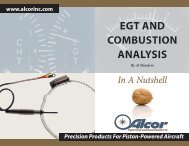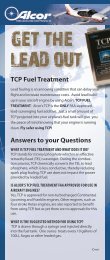Manual
Manual
Manual
Create successful ePaper yourself
Turn your PDF publications into a flip-book with our unique Google optimized e-Paper software.
Alcor, Inc. ● 300 Breesport St., San Antonio, TX 78216<br />
TCP Fuel Treatment<br />
MATERIAL SAFETY DATA SHEET<br />
Page 2 of 6<br />
Updated October 8, 2008<br />
Skin Contact:<br />
Causes irritation to skin. Symptoms include redness, itching, and pain. Repeated or prolonged<br />
contact with the skin has a defatting effect and may cause dryness, cracking, and possibly<br />
dermatitis.<br />
Eye Contact:<br />
Causes irritation, redness, and pain.<br />
Chronic Exposure: Chronic overexposure may cause anemia with leukocytosis (transient increase<br />
in the white blood cell count) and damage to the liver and kidneys. Dermatitis, skin defatting may<br />
also occur with use of this material.<br />
Aggravation of Pre-existing Conditions: Persons with pre-existing skin disorders or eye<br />
problems, or impaired liver, kidney or respiratory function may be more susceptible to the effects of<br />
the substance.<br />
4. FIRST AID MEASURES<br />
Inhalation: Remove to fresh air. If not breathing, give artificial respiration. If breathing is difficult,<br />
give oxygen. Get medical attention.<br />
Ingestion: Give large amounts of water to drink. Never give anything by mouth to an unconscious<br />
person. Get medical attention immediately. Do not induce vomiting.<br />
Skin Contact: Immediately flush skin with plenty of soap and water for at least 15 minutes. Remove<br />
contaminated clothing and shoes. Get medical attention. Wash clothing before reuse. Thoroughly<br />
clean shoes before reuse.<br />
Eye Contact: Immediately flush eyes with plenty of water for at least 15 minutes, lifting lower and<br />
upper eyelids occasionally. Get medical attention immediately.<br />
5. FIRE FIGHTING MEASURES<br />
Fire: Flash point: 32C (90F) CC<br />
Autoignition temperature: 204C (399F).<br />
Flammable limits in air % by volume: lel: 1.0%; uel: 6.0%<br />
Flammable Liquid and Vapor! Contact with strong oxidizers may cause fire.<br />
Explosion: Above flash point, vapor-air mixtures are explosive within flammable limits noted above.<br />
Sealed containers may rupture when heated. Sensitive to static discharge.<br />
Fire Extinguishing Media: Water spray, dry chemical, alcohol foam, or carbon dioxide. Water may be<br />
ineffective. Water spray may be used to keep fire exposed containers cool.<br />
Special Information: In the event of a fire, wear full protective clothing and NIOSH-approved selfcontained<br />
breathing apparatus with full facepiece operated in the pressure demand or other positive<br />
pressure mode. Water may be used to flush spills away from exposures and to dilute spills to nonflammable<br />
mixtures. Vapors can flow along surfaces to distant ignition source and flash back.<br />
6. ACCIDENTAL RELEASE MEASURES<br />
Ventilate area of leak or spill. Remove all sources of ignition. Wear appropriate personal protective<br />
equipment as specified in Section 8. Isolate hazard area. Keep unnecessary and unprotected<br />
personnel from entering. Contain and recover liquid when possible. Use non-sparking tools and<br />
equipment. Collect liquid in an appropriate container or absorb with an inert material (e. g.,<br />
vermiculite, dry sand, earth), and place in a chemical waste container. Do not use combustible<br />
materials, such as saw dust. Do not flush to sewer! US Regulations (CERCLA) require reporting<br />
spills and releases to soil, water and air in excess of reportable quantities. The toll free number for<br />
the US Coast Guard National Response Center is (800) 424-8802. If a leak or spill has not ignited,<br />
use water spray to disperse the vapors, to protect personnel attempting to stop leak, and to flush<br />
spills away from exposures.






